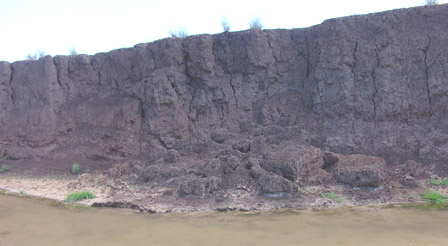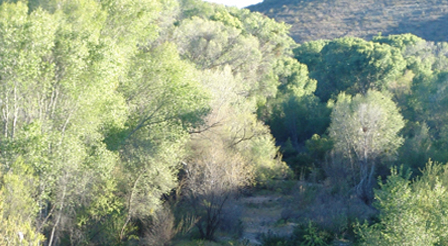

From Marshes and Cienegas to Gallery Forests:
A Brief Overview of San Pedro River Basin History
(See the bottom of the page for reference sources, of which this essay is largely a precis.)
Hendrickson & Minckley (1985, see below) say that before 1880, southeastern Arizona streams ran mostly unincised across alluvial fills in shallow, braided channels, often through lush marshes, unlike today where sandy, barren streambeds lie entrenched between vertical walls that drop many feet below now-dry valley surfaces. James Ohio Pattie and his companions regarded the San Pedro as "Beaver River" when they first saw it in March 1825 because of large numbers of these swamp-denizens they found (and trapped) there. Other early accounts describe a little-incised, lush valley with high grass, boggy banks, and a river that flowed perennially (though the flow did go underground sometimes at various stretches). The flow was mostly quite slow, and [as Hastings & Turner, 1965, see below, report that other 19th century visitors said,] "about every five miles there is a beaver dam this is a great Country for them" (1858). "Fish are abundant in this pretty stream. Salmon trout [perhaps Colorado River Squawfish?] are caught by the men in great numbers". In some places, "the bottom lands of the San Pedro... were covered with a dense growth of sacaton grass...." (1858), and below one cut, the river "widens out, and from beaver dams and other obstructions overflows a large extent of bottom land, forming marshes, densely timbered with cottonwood and ash...."(1859) (On the other hand, in some places "the river bottom is a dense thicket of bramble bush, mostly muskeet....") Fremont Cottonwood and Goodding Willow trees (today forming long stretches of Fremont Cottonwood-Goodding Willow Gallery Forest) were present along the river's length, but only in scattered numbers, while substantial stretches were quite wet but largely treeless.
At " The Narrows" about 15 miles north of Benson (where deep valley fill upstream meets a bedrock outcrop that forces water to the surface), the stream then spread out widely to the north below the gorge, forming sporadically extensive swamps with beaver dams running all the way past Cascabel. Malaria became quite serious in the late 1860s at Camp Grant near the junction of Arivaipa Creek with the River, while the Mormon Settlers who established St. David in 1877 were dying of malaria by 1879. (In that year, the Arizona Daily Star described the San Pedro as "the valley of the shadow of death" because of the serious incidence of malaria there, reflecting its then-pervasive swampy conditions.) Aquatic and semi-aquatic habitats apparently extended all the way from the Mexican Border and the Huachuca Mountain fringes to just north of Cascabel, with further swamplands located around the Redfield Canyon confluence and the Aravaipa Stream confluence.
Apparently, many of these marshes were cienegas. According to Hendrickson & Minckley, cienegas are permanently saturated wetlands with highly organic, "anoxic-reducing" soils (low air supply, high carbon monoxide content), usually found in Arizona from about 3,000 feet altitude or more, in low-relief drainages where winter conditions are mild and headwaters well-vegetated so that flood scourings are unlikely. The air-poor hydro-soils that result from the standing water produce a distinctive and stable, if restricted flora (semiaquatic sedges and grasses) with few trees in the swampland itself. Sacaton Grass stands and typical riparian trees may grow near marsh edges above the water-saturated and often salinated borders. Cienegas act as traps for large amounts of organic materials, and make downstream flows less variable and more permanent, fostering rise of water tables. Thus they contribute greatly to biome productivity, supporting relic populations of small fauna (including various fishes) and stimulating concentration of various herbivores.
Marshes in oxbows and along margins of major streams are different riverine structures, supporting more complex flora in well aerated hydrosoils. Willows and cottonwoods form galleries along drier alluvial terraces. But such habitats are transitory, developing rapidly but then being removed by channel-straightening floods or by gradual drying of relic oxbows. Cienegas in contrast may become quite long-lived systems.
Hendrickson & Minckley say that, while 125 previous years of Spanish/Mexican exploitation had included some locally large livestock herds, most Arizona ranching ventures were short-lived until Anglo-American activities expanded after the railroad arrived at Benson in the 1880s. During those days, they say, cattle had to concentrate within a 3-mile radius of natural waters (stock-tank development began only around 1900), so degradation of these natural waters accelerated. With severe overgrazing, cienegas and their supporting environments in the San Pedro were destructively trampled, and a well-documented cycle of arroyo cutting began, destroying these aquatic and semiaquatic habitats. (Such processes have been best documented along the Santa Cruz River near Tucson, where lush grasslands and marshlands existed near San Xavier del bac, downstream near "A" Mountain in Tucson, and along the lower Rillito Wash, then a perennial stream at Ft. Lowell, prior to the devastating arroyo cutting which began near man-made structures along the Santa Cruz River and progressed upstream during the floods of 1890-92 and the drought of 1893 and later. Compare this with conditions of the Tucson-area washes of recent times.)
Today, the sole remnant cienega to be found in our area (the Middle San Pedro) lies in the Buehmann Canyon drainage, an important tributary of the San Pedro running out of the Catalina Mountains near Redington. The Bingham Cienega contains not only cienega wetlands but also palustrine wooded swamp, cottonwood-willow riparian forest, and mesquite bosque, and has been designated a Natural Preserve. Its distinctive swampland appears to result from subflows deriving from the San Pedro River, augmented by those from Buehmann, Redfield, and Edgar Canyons running down from the Catalina Mountain complex. (See Daniel Baker's essay on this important Natural Preserve.)
Hastings & Turner (1965), in contrast, point out that from the time of their earliest incursions the Spaniards brought sheep, horses, and cattle down the San Pedro River Valley, and in the 1690s Fr. Eusebio Kino gave out cattle and other domestic livestock to the Native Americans he was seeking to missionize. By 1700 the intensity of grazing to the south, in Sonora, was high, and yet arroyo cutting did not occur in that region until nearly two centuries later -- the same time it began in our area.
Hastings & Turner continue: While Mexican settlers did large-scale cattle-raising in the 1820s-30s, really massive cattle ranching only began with Anglo-American stock-raising after the Civil War -- especially following the U.S. Army's reduction of Apache raiding after 1870, and the arrival of the transcontinental railroad in Tucson in 1880. Trail drives from Sonora and Texas even earlier brought in thousands of head -- Hooper and Hooker alone brought in four herds totaling 15,500 animals in 1872. Where there had been only 5,000 cattle in all of Arizona Territory in 1870, by 1880 the San Pedro Valley alone supported perhaps 8,000 head of cattle and 10-12,000 sheep. A ballyhoo campaign holding that "grass is gold" brought an inflow of capital and entrepreneurs. By 1890 one census showed over a million range cattle in Arizona as a whole, and the Southwestern Stockman of January 1891 conceded that "the malady of overcrowding is with us in an aggravated form...."
Ecological disaster followed: to quote further from Hastings and Turner's account, "The summer rains of 1891 were well below normal. In the arid foresummer of 1892 stock began to die. The summer rains of 1892 again were scanty, and by the late spring of 1893 the losses were 'staggering' (Report of the Governor 1896:22). 'Dead cattle lay everywhere. You could actually throw a rock from one carcass to another".... Hastings and Turner then summarize the impact of the overgrazing on regional ecology: "Thousands of square miles of grassland, denuded of their cover, lay bared to the elements. The cropping unquestionably weakened the old plant communities, leaving them open to invasion; it unquestionably upset the balance between infiltration and runoff, in favor of the latter." (page 41)
However, having said all this, Hastings & Turner then observe that flooding in this region can be documented well back into the Spanish period, and that flooding has likely been occurring as long as arid and semiarid conditions have prevailed, due to chronically sparse ground cover coupled with occasionally intense rainfalls. Still, before the 1880s, floods tended to spread out over flood plains in shallow sheets, a pattern which changed only in the mid-1880s: In 1886, "'the water in the San Pedro River was higher than it was ever known to be...." (H&T p. 42) Floods occurred in 1888, in 1889, and then in 1890 large channels were carved upstream by the floods in both the San Pedro and the Santa Cruz Rivers. "Of the country down the San Pedro, from Tres Alamos to the Gila [Captain Van Alstine]... says, 'all of it is gone, destroyed, torn up, 'vamosed down with high water.' He never saw such a destruction in all his life."
Hastings and Turner argue that removal of ground cover -- by whatever agency (human, drought, or cattle) --will unfailingly increase runoff and surface erosion. Human agency such as roads, trails, and drainage ditches definitely tend to become runoff points which rapidly enlarge because of their barrenness. However, geological evidence also indicates that a number of erosion cycles have occurred in the American Southwest since late Pleistocene times, and Kirk Bryan has argued that "Arroyos similar to and even larger than the recent arroyos were cut in past time. As these ancient episodes of erosion antedate the introduction of grazing animals, they must be independent of that cause.... It seems reasonable that the present arroyo is essentially climatic in origin... [and that overgrazing has been] merely the trigger pull which timed the arroyo cutting in the thirty years following 1880." (H&T, p. 43; bold print added)
In their work of 2007, Webb, Leake, & Turner (see below) carry the historical process further, observing that "Riparian vegetation has generally increased along the river north of the U.S.-Mexico border.... Following channel widening that ceased in the early 1940s, low alluvial terraces were deposited that allowed colonization by woody riparian vegetation in the effluent-influent reaches. Riparian vegetation has steadily increased despite episodic flooding...." They go on to say,
"Ultimately, the case of riparian vegetation change on the San Pedro River represents one of the largest increases in woody riparian vegetation in the Southwest. Many researchers have noted that this river, once swampy, now sustains a verdant forest. If cattle grazing caused arroyos to downcut, then it created this forest because growth and establishment of most of these woody trees required dewatering of the upper few feet of a once saturated alluvial aquifer and disturbance." (p. 223)
.............................................
Note: This brief essay is drawn directly from the following three sources: the article, "Cienegas", by Hendrickson and Minckley, published in Desert Plants, 6:3:131-75 (1985). Hastings & Turner (1965), The Changing Mile: An Ecological Study of Vegetation Change with Time in the Lower Mile of an Arid and Semiarid Region, Tucson: University of Arizona Press, and Webb, Leake, & Turner, 2007, The Ribbon of Green: Change in Riparian Vegetation in the Southwestern United States, Tucson: University of Arizona Press.